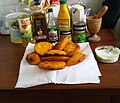This article needs additional citations for verification .(June 2015) |
Venezuelan cuisine is influenced by its European [1] (Italian, Spanish, Portuguese, German, and French), West African, and indigenous traditions. Venezuelan cuisine varies greatly from one region to another. Food staples include corn, rice, plantains, yams, beans and several meats. [1] [2] [3]
Contents
Potatoes, tomatoes, onions, eggplants, squashes, spinach and zucchini are also common side dishes in the Venezuelan diet. Ají dulce and papelón are found in most recipes. Worcestershire sauce is also used frequently in stews. Venezuela is also known for having a large variety of white cheese (queso blanco), usually named by geographical region. Italian settlers contributed pasta and meat products, while German settlers introduced Berliners (which are locally called bomba) and kuchens.
Venezuelans have three main meals: a large breakfast, a large dinner (around noon), and a very light supper in the evening. Venezuelan hospitality is widespread, so something to drink and eat is expected when visiting someone's home. Arepas, the most distinctive Venezuelan food, are thick disks made of precooked cornmeal, either fried or baked. Large arepas, with a variety of fillings (ham and cheese is the most popular one), are eaten as snacks throughout the day; smaller arepas are typically served as side companions at all meals.[ citation needed ]


























